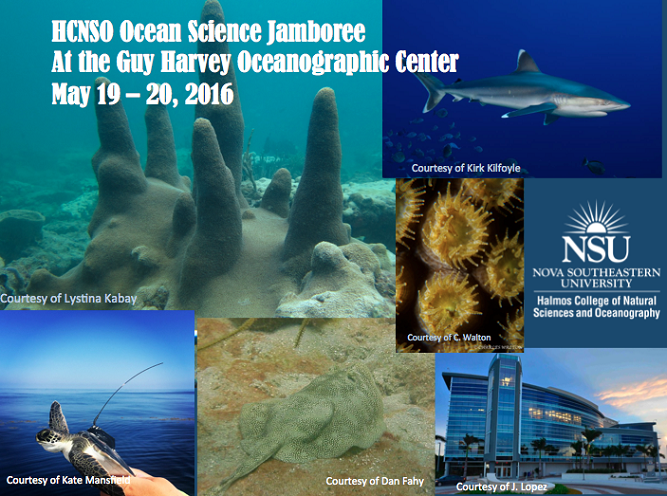Microbial community dynamics in the northwestern Gulf of Mexico
Location
Guy Harvey Oceanographic Center Facility
Start
5-19-2016 1:45 PM
End
5-19-2016 2:00 PM
Abstract
Background/Question/Methods: The Gulf of Mexico (GOM) is a dynamic ecosystem influenced multiple processes that can greatly alter water conditions. This ecosystem is affected by the gulf loop current dynamics that brings warm nutrient poor water from the Caribbean, freshwater input by the Mississippi river, natural seeps and leaks of hydrocarbons from the ocean floor, and more recently, anthropogenic influences of the Deepwater horizon oil spill and eutrophication due to agriculture along the Mississippi river basin. Microbial communities form the base of complex food webs in the GOM, but we know little about how these communities vary in response to these naturally occurring fluctuations in environmental conditions, as well as in response to anthropogenic disturbances. The current study will investigate spatial and temporal variation in microbial community at different depths across a stratified sampling grid in the northwestern GOM. Seawater samples were collected on biannual cruises at 5 sites in cruise 1 and 11 sites during cruise 2. Seawater samples were collected at 4 depths representing distinct pelagic zones. Next-generation sequencing on an Illumina MiSeq was used to capture the microbiome of from each sample. Analysis of microbial community diversity and composition was conducted to assess spatial, temporal, and depth variation among samples as well as how these patterns are related to broader oceanographic features at the time of collection.
Results/Conclusions: This study will help establish an important baseline regarding natural fluctuations in microbial communities across these different environmental influences. Initial results indicate that microbial communities were highly variable among sampling sites for both cruises, but no clear geographic patters emerged. Depth was a major factor influencing diversity and composition of microbial communities. Microbial composition displayed clear depth stratification between photic and aphotic zones. Differences among depths were driven in part by increased abundance of Cyanobacteria in the photic depths, and higher abundance of Crenarcheota in aphotic depths. Samples collected during cruise 1, which occurred in spring months showed higher overall microbial diversity compared to samples from cruise 2 during late summer months. Ongoing analysis is focused on relating these observed patterns of microbial diversity and composition to oceanographic features such as water chemistry, chlorophyll a concentration, temperature, and megafauna abundance and currents during the time of collection. Combining these data will allow for a more complete image of what factors are controlling these essential communities in the GOM.
Microbial community dynamics in the northwestern Gulf of Mexico
Guy Harvey Oceanographic Center Facility
Background/Question/Methods: The Gulf of Mexico (GOM) is a dynamic ecosystem influenced multiple processes that can greatly alter water conditions. This ecosystem is affected by the gulf loop current dynamics that brings warm nutrient poor water from the Caribbean, freshwater input by the Mississippi river, natural seeps and leaks of hydrocarbons from the ocean floor, and more recently, anthropogenic influences of the Deepwater horizon oil spill and eutrophication due to agriculture along the Mississippi river basin. Microbial communities form the base of complex food webs in the GOM, but we know little about how these communities vary in response to these naturally occurring fluctuations in environmental conditions, as well as in response to anthropogenic disturbances. The current study will investigate spatial and temporal variation in microbial community at different depths across a stratified sampling grid in the northwestern GOM. Seawater samples were collected on biannual cruises at 5 sites in cruise 1 and 11 sites during cruise 2. Seawater samples were collected at 4 depths representing distinct pelagic zones. Next-generation sequencing on an Illumina MiSeq was used to capture the microbiome of from each sample. Analysis of microbial community diversity and composition was conducted to assess spatial, temporal, and depth variation among samples as well as how these patterns are related to broader oceanographic features at the time of collection.
Results/Conclusions: This study will help establish an important baseline regarding natural fluctuations in microbial communities across these different environmental influences. Initial results indicate that microbial communities were highly variable among sampling sites for both cruises, but no clear geographic patters emerged. Depth was a major factor influencing diversity and composition of microbial communities. Microbial composition displayed clear depth stratification between photic and aphotic zones. Differences among depths were driven in part by increased abundance of Cyanobacteria in the photic depths, and higher abundance of Crenarcheota in aphotic depths. Samples collected during cruise 1, which occurred in spring months showed higher overall microbial diversity compared to samples from cruise 2 during late summer months. Ongoing analysis is focused on relating these observed patterns of microbial diversity and composition to oceanographic features such as water chemistry, chlorophyll a concentration, temperature, and megafauna abundance and currents during the time of collection. Combining these data will allow for a more complete image of what factors are controlling these essential communities in the GOM.


